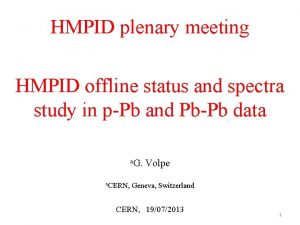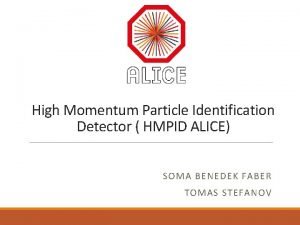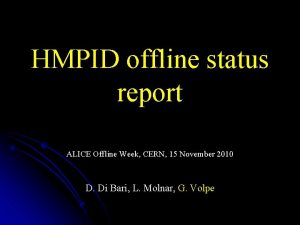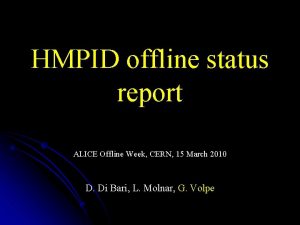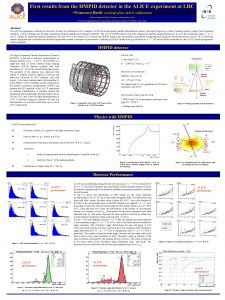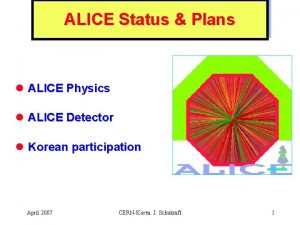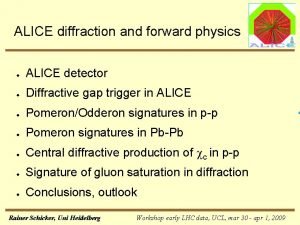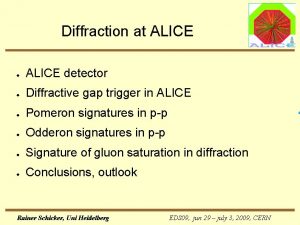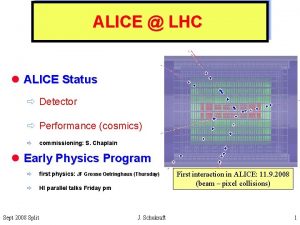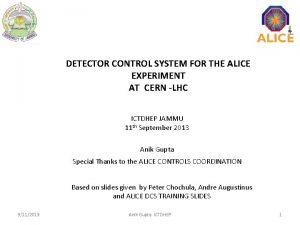The ALICE HMPID Detector Control System its evolution
















- Slides: 16

The ALICE HMPID Detector Control System, its evolution towards an expert and adaptive system G De Cataldo on behalf of the ALICE-HMPID group RICH 2010 Cassis. G. De Cataldo, A Franco and G. Volpe INFN Bari It and CERN-CH 1 6 May 2010

Presentation Outline l l The High Momentum Particle Identification Detector (HMPID) in ALICE @ LHC The HMPID Detector Control System (DCS): the complementary detector’s devices (HV, LV pws, PLC…), processes and device controls and finally PVSS the Slow Control And Data Acquisition System (SCADA); l The DCS Finite State Machines structure and User Interface; l HAL 9000 to feature the ‘Expert Control System’ for complex problem solution; l Adaptive features in a DCS: benefits and drawbacks, would the HMPID profit of the method? l Summary RICH 2010 Cassis. G. De Cataldo, A Franco and G. Volpe INFN Bari It and CERN-CH 2 6 May 2010

The HMPID, a proximity focusing RICH based on MWPC and Cs. I photocathode RICH 2010 Cassis. G. De Cataldo, A Franco and G. Volpe INFN Bari It and CERN-CH 3 6 May 2010

The HMPID in the context of ALICE (09/2006) RICH 2010 Cassis. G. De Cataldo, A Franco and G. Volpe INFN Bari It and CERN-CH 4 6 May 2010

THE HMPID DCS control devices HMPID RICH 2010 Cassis. G. De Cataldo, A Franco and G. Volpe INFN Bari It and CERN-CH 5 6 May 2010

PVSS the SCADA @ CERN l PVSS is a Slow Control and Data Acquisition System (SCADA) for the process control engineering of the Austrian company ETM; l Adopted @ CERN in the Joint. COntrol. Project for the four experiments at LHC, PVSS has been endowed with additional tools aiming to simplify the programmer task in developing and implementing DCSs (Framework for device interface, trending, alarm management, ORACLE database interface, Finite State Machine interface (SMI++), Graphical User Interface …. . ) RICH 2010 Cassis. G. De Cataldo, A Franco and G. Volpe INFN Bari It and CERN-CH 6 6 May 2010

The Finite State Machine modeling l What’s a FSM? It is a software process modeling a device behavior; l It accept commands and after computation sets corresponding logic state; l basic FSM units as Control, Logic and Device units with different role can be integrated in a hierarchy up to model the full detector behavior. RICH 2010 Cassis. G. De Cataldo, A Franco and G. Volpe INFN Bari It and CERN-CH 7 6 May 2010

HMPID UI and FSM HIERARCHY User Interface designed in the HMPID DCS group and used in all the ALIDCE DCS projects Monitoring zone Control zone RICH 2010 Cassis. G. De Cataldo, A Franco and G. Volpe INFN Bari It and CERN-CH 8 6 May 2010

‘Expert and Adaptive Systems’: motivations • Motivations: • A reduction of shifters for the experiment operation (and for the HMPID operation as well) seems to be a desiderata of the full ALICE collaboration (long trips from home institutes and permanence at CERN may be expensive), • At the same time the necessity of maximize the event statistics for physics with stable condition detectors is a must! • With such competitive processes the exploration of the potentialities of an Expert and Adaptive Control System aiming to replace human experts can find solid justifications. RICH 2010 Cassis. G. De Cataldo, A Franco and G. Volpe INFN Bari It and CERN-CH 9 6 May 2010

‘Expert and Adaptive Systems’: basic concepts An Expert system is supposed to take decision replacing the human expert while controlling a process (in our case a RICH); How to implement an Expert System for the HMPID? 1) first collect and organize in a computer the human expert knowledge, it is not a trivial task but feasible (knowledge base)! 2) prepare the decisions the Expert Control System has to take following the knowledge base. An Adaptive system keeps constant the controlled process performance when key parameters drift affect the process; How to implement an Adaptive System for the HMPID? 3) First define rules describing the detector dependence v. s. key parameters drift e. g. : Ggas=Ggas(HV, P, T); 4) Close the detector (the process) output-input feedback loop via the Ggas transfer function. RICH 2010 Cassis. G. De Cataldo, A Franco and G. Volpe INFN Bari It and CERN-CH 10 6 May 2010

‘Expert System replacing human expert In practice how should it work ? E. g. : let’s assume an increase of T is detected in one detector module; instead of switching OFF the full module when T > Tthreshold (threshold behavior) , an expert system should start to crosscheck such event with : • Increasing drained current in FE or RO electronics (higher dissipated power)? • Increasing temperature of the cooling water? • Anomalies in the cooling plant? …………………. On the base of this analysis and before threshold behavior, the Expert System can: • send a message describing the anomaly, • if operator doesn’t taken corrective actions then later it can decide : - either to switch OFF a LV segment in case of increase of drained current; or - the full module in case of cooling problem; - the seven modules (full detector!) in case of cooling plant malfunctioning. In each case a specific FSM command is available. Of course much more complex scenarios can be managed RICH 2010 Cassis. G. De Cataldo, A Franco and G. Volpe INFN Bari It and CERN-CH 11 6 May 2010

HAL 9000: the HMPID ‘Expert A building up phase of Control System’ HAL 9000 is now under way while we accumulate experience in the HMPID operation (2006 -. today) Systems Connections HV - LV • In the panel are summarized relevant information used by HAL 9000, the expert control script. Cooling • The script runs in background and using the knowledge base it can take decisions accordingly. Messages RICH 2010 Cassis. • Of course, as complex as needed, different scenarios of malfunctioning conditions and relevant recovering actions can be prepared. G. De Cataldo, A Franco and G. Volpe INFN Bari It and CERN-CH 12 6 May 2010

Adaptive Control System for optimal and constant performance How it works: the output of the process is compared to a reference set point and any difference (error signal) can be used via a control function to correct the process output. For gaseous detector (PID using multiple d. E/dx measurements) or GAPD where a constant gain is mandatory such adaptive control could use the HV to correct for possible gas gain drift caused by gas pressure and/or temperature variations; Vexata quaestio: Does the HMPID need such an Adaptive System? RICH 2010 Cassis. G. De Cataldo, A Franco and G. Volpe INFN Bari It and CERN-CH 13 6 May 2010

HMPID performance v. s. gas gain 1 st In the HMPID once the Cherenkov single photo-electron signal is discriminated via a low level threshold then its counting rate (digital signal processing) shows a negligible dependence from the gas gain variation (good ratio signal/noise). This can be seen from test beam data in Fig. 1 for the Cherenkov angular resolution ( prop. 1/SQRT(Nph) ) that changes only 12% wrt 600% of gas gain variation in the same HV interval 1950 - 2150 (Tab. 1). For a more realistic gas gain variation of +-50% (equivalent to HV operation range 2000 -2100 V) the HMPID doesn’t show any relevant performance degradation. RUN Tension(Volt) Average pulse hight (ADC channels) 1786 1950 204 1790 2000 322 1792 2050 501 1795 2100 798 1796 2150 1289 Tab 1. MIP average pulse hight v. s. HV RICH 2010 Cassis. Fig. 1 Angular resolution of the average Cherenkov angle v. s. HV G. De Cataldo, A Franco and G. Volpe INFN Bari It and CERN-CH 14 6 May 2010

HMPID performance v. s. gas gain 2 nd • So, does the HMPID behavior requires an adaptive mechanism to correct gas gain drift? • Frankly speaking NO, in addition possible drawbacks as oscillating or diverging corrections could be introduced in the control feedback (although the Fuzzy logic seems to be a promising technique). • Nevertheless, we intend to explore anyway the subject for two folded reasons: • appearance of effects on detector performance after massive experimental data analysis is carried out; • Or to bring the research results in the ALICE DCS environment where detectors using analog signal processing (e. g. : PID via relativistic rise of d. E/dx) could profit of such technique ensuring long period of good and stable data quality. RICH 2010 Cassis. G. De Cataldo, A Franco and G. Volpe INFN Bari It and CERN-CH 15 6 May 2010

Summary l l The HMPID DCS based on the PVSS SCADA system is in full in production since 2006; The DCS Finite State Machines structure and the UI have proven to be a very user friendly tool to remotely operate the detector (HMPID UI is used in all the ALICE DCS projects); the ‘Expert Control System’ for complex decision seems to be a possible solution to reduce the human intervention in the detector operation (for spatial mission like “ 2001: A Space Odyssey” due to its complexity, this approach was considered mandatory!!); Adaptive features in the HMPID DCS seems to be not necessary, nevertheless for effects that might appear after massive data analysis and for detectors that in ALICE use analog signal processing (e. g. : PID via d. E/dx) the investigation remains of interest. RICH 2010 Cassis. G. De Cataldo, A Franco and G. Volpe INFN Bari It and CERN-CH 16 6 May 2010
 The emigree annotations
The emigree annotations When a train increases its velocity, its momentum
When a train increases its velocity, its momentum Sunny rainy windy snowy
Sunny rainy windy snowy If its a square it's a sonnet summary
If its a square it's a sonnet summary Its halloween its halloween the moon is full and bright
Its halloween its halloween the moon is full and bright Its not easy but its worth it
Its not easy but its worth it Hình ảnh bộ gõ cơ thể búng tay
Hình ảnh bộ gõ cơ thể búng tay Lp html
Lp html Bổ thể
Bổ thể Tỉ lệ cơ thể trẻ em
Tỉ lệ cơ thể trẻ em Chó sói
Chó sói Tư thế worm breton
Tư thế worm breton Bài hát chúa yêu trần thế alleluia
Bài hát chúa yêu trần thế alleluia Các môn thể thao bắt đầu bằng tiếng nhảy
Các môn thể thao bắt đầu bằng tiếng nhảy Thế nào là hệ số cao nhất
Thế nào là hệ số cao nhất Các châu lục và đại dương trên thế giới
Các châu lục và đại dương trên thế giới Công thức tiính động năng
Công thức tiính động năng

















